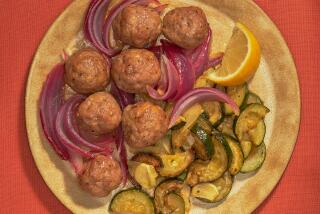Add a Little Here, Sub a Little There . . . and End Up With a Better Diet
- Share via
We sometimes get bogged down in counting numbers and trying to figure out the best diets for our families, but judging from some recent mail we received, it might be helpful to offer some practical tips that can make the job less daunting.
* For low-fat meat, choose skinless turkey breast--it’s just about the leanest meat you can find. A 3-ounce portion has less than a gram of fat (5% of calories). Stick with plain roasted turkey; the self-basting birds and turkey cold cuts can still be high in fat.
* To cut down on the amount of cholesterol you get from eggs, substitute two whites for every whole egg. You can still enjoy omelets and souffles, cakes and muffins by using whites, nonfat dry milk and skim milk. Or if two eggs are called for, cut the cholesterol in half by using two whites plus one whole egg.
* Get your fiber from your food, not supplements. Most fiber pills actually don’t have much fiber. You can get all the fiber you need from food and at a lower cost if you make sure your diet contains enough fruits, vegetables, legumes and whole grains.
* To get the most nutrients from a baked potato, eat the skin, too. Ounce for ounce, it has more fiber, iron, potassium and B vitamins than the inside. Just make sure the skin doesn’t have a greenish tinge. That means the potato has been exposed to too much light after harvest and that solanine (a natural toxin that can make you sick) may be present.
* If you have frequent headaches and can’t find a reason, look at what you eat. Foods and beverages can sometimes play a role in headaches, especially the migraine variety. Some of the usual suspects are chocolate, ripe cheeses and freshly baked yeast products, which contain a chemical called tyramine that may affect the blood vessels in the brain.
* Drink tea. It contains enough fluoride to help prevent tooth decay and is also rich in polyphenols, which act like antioxidants (substances that may prevent cell damage).
* Bring cooking water to a boil before adding vegetables. This destroys fewer nutrients. Better yet, steam or microwave vegetables in a tiny amount of water.
* To cut down on salt, try adding a few drops of lemon juice to foods. This not only perks up flavor, but also gives even a little salt more bounce.
* Store tomatoes at room temperature. They taste better because cold temperatures lower the level of certain flavor components in the tomato and ruin the texture.
* Make sure your frozen yogurt is made from low-fat or nonfat milk. Brands made from whole milk (or those containing added fat) can be as high in fat as ice cream. Now that is a cruel joke!
* To minimize vitamin losses due to exposure to air, cut fruits and vegetables into thick slices or chunks as close to serving time as possible.
* Enhance your diet with foods rich in carotenoids, notably beta carotene, which the body turns into vitamin A. Good choices are carrots, sweet potatoes, cantaloupe and dark leafy greens.
* Even with a good diet that includes five to six servings of fruits and vegetables, it’s a good idea to protect yourself with some antioxidant supplements. We recommend 250 to 500 milligrams of vitamin C, 200 to 800 international units of vitamin E and folacin for women of childbearing years.
* Frozen broccoli contains more beta carotene ounce per ounce than fresh because the frozen packages generally contain more of the tender buds or florets, which are higher in beta carotene than the stalks.
* Try carrot juice for a change. A cup has as much beta carotene and vitamin C as three medium carrots, though less fiber than one carrot.
* Bagels are low in fat but may be higher in calories than you think. Some fresh-baked bagels weigh 6 or 7 ounces and can have 500 calories or more.
* To make a lower-fat salad dressing, just change the oil and vinegar ratio. Instead of 3-1 ratio of oil to vinegar, try a 1-1 mix. It helps to use a flavorful oil, such as olive, sesame or nut oils so you’ll need less. You can also try plain lemon or lime juice, salsa, balsamic or rice vinegar or a flavored vinegar (like raspberry).
* If you like cold noodles with peanut sauce--like those your favorite Chinese restaurant serves--try making your own with less fat. Mix 4 tablespoons of smooth peanut butter with the juice of a lemon, 2 teaspoons of reduced sodium soy sauce, 1 tablespoon of water and some chopped scallions. Blend and toss with cold cooked fettuccine or linguine.
* For a lower-fat guacamole, blend a medium-sized avocado with 1 cup of low-fat cottage cheese. Add 1 tablespoon of lime juice, 1 teaspoon of chopped chives and one-quarter teaspoon of red pepper flakes. A serving has about 60 calories and 4 grams of fat (about half as much as regular guacamole.)
* Make your own low-fat tortilla chips by baking fresh tortillas at 400 degrees for 8 to 10 minutes, or until crisp. You can cut them into triangles before baking or break them into chips afterward. Serve with the low-fat guacamole.
*
Dr. Sheldon Margen is a professor of public health at UC Berkeley; Dale A. Ogar is managing editor of the UC Berkeley Wellness Letter. Send questions to Dale Ogar, School of Public Health, UC Berkeley, Berkeley, CA 94720-7360, or e-mail to daogar@uclink4.berkeley.edu.
More to Read
Eat your way across L.A.
Get our weekly Tasting Notes newsletter for reviews, news and more.
You may occasionally receive promotional content from the Los Angeles Times.










